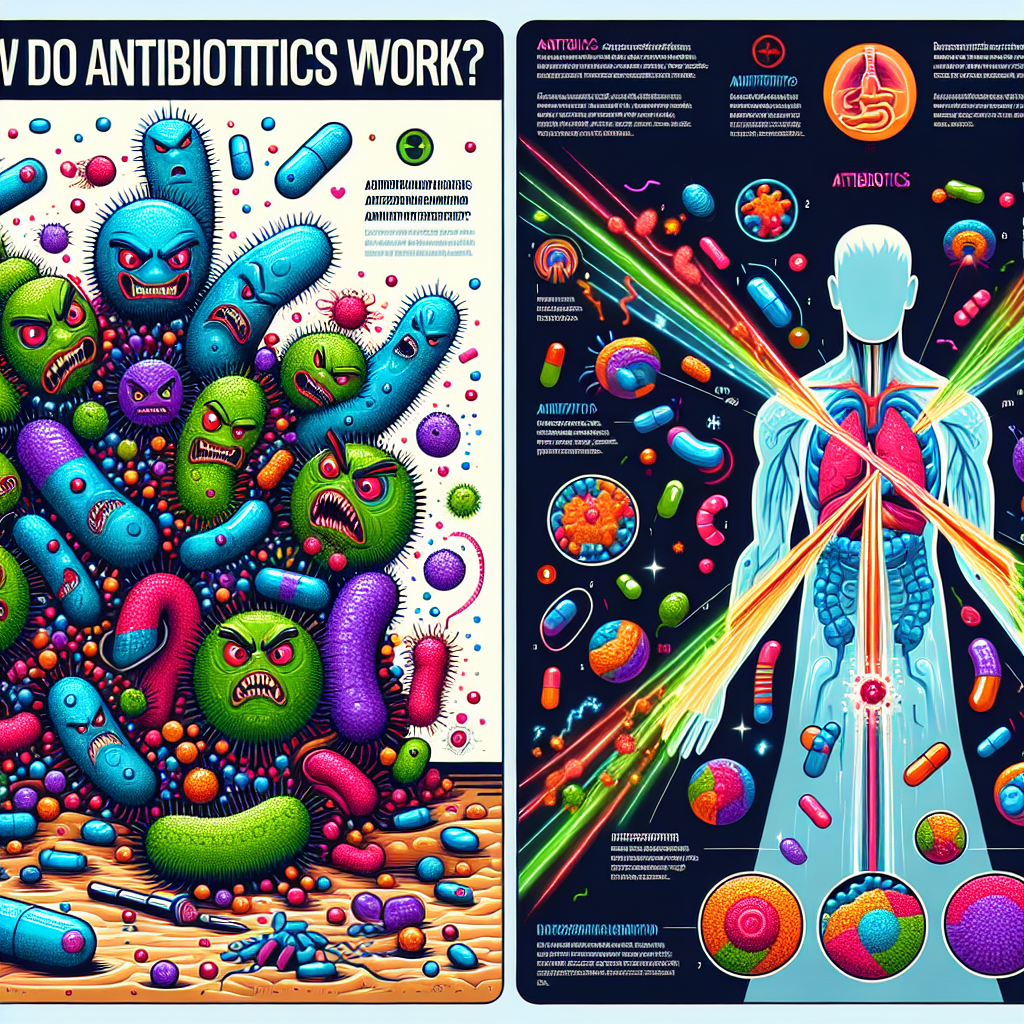Antibiotics are powerful medications that have revolutionized modern medicine by effectively treating bacterial infections. They work by targeting specific bacteria and either killing them or inhibiting their growth. This article will explore how antibiotics work, the different types of antibiotics, and common questions about their use.
How do antibiotics work?
Antibiotics work by targeting specific components of bacterial cells that are essential for their survival. There are several ways in which antibiotics can affect bacterial cells:
1. Inhibition of cell wall synthesis: Many antibiotics, including penicillin and cephalosporins, work by inhibiting the synthesis of the bacterial cell wall. Bacterial cell walls are made up of a complex structure called peptidoglycan, which provides structural support and protection for the cell. By preventing the synthesis of peptidoglycan, these antibiotics weaken the cell wall, causing the bacteria to burst and die.
2. Inhibition of protein synthesis: Other antibiotics, such as tetracyclines and macrolides, work by inhibiting protein synthesis in bacterial cells. Proteins are essential for the survival of bacteria, as they play a crucial role in various cellular processes. By blocking the production of proteins, these antibiotics prevent the bacteria from growing and reproducing.
3. Disruption of nucleic acid synthesis: Some antibiotics, such as fluoroquinolones and rifamycins, work by disrupting the synthesis of nucleic acids in bacterial cells. Nucleic acids, including DNA and RNA, are essential for the replication and transcription of genetic information in bacteria. By interfering with the synthesis of nucleic acids, these antibiotics prevent the bacteria from reproducing.
4. Interference with metabolic pathways: Certain antibiotics, such as sulfonamides and trimethoprim, work by interfering with essential metabolic pathways in bacterial cells. Metabolic pathways are complex series of chemical reactions that are necessary for the survival of bacteria. By targeting specific enzymes involved in these pathways, these antibiotics disrupt the cellular metabolism of bacteria, leading to their death.
5. Inhibition of cell membrane function: Some antibiotics, such as polymyxins and daptomycin, work by disrupting the function of the bacterial cell membrane. The cell membrane is essential for maintaining the integrity and stability of bacterial cells. By disrupting the cell membrane, these antibiotics cause leakage of cellular contents and ultimately lead to bacterial cell death.
Overall, antibiotics target specific components of bacterial cells to either kill them or inhibit their growth. It is important to note that antibiotics are effective only against bacterial infections and do not work against viral infections.
Types of antibiotics
There are several classes of antibiotics that are commonly used to treat bacterial infections. Some of the most common classes of antibiotics include:
1. Penicillins: Penicillins are a group of antibiotics that are derived from the fungus Penicillium. They work by inhibiting the synthesis of the bacterial cell wall and are effective against a wide range of bacterial infections. Some common penicillins include amoxicillin and ampicillin.
2. Cephalosporins: Cephalosporins are a group of antibiotics that are structurally related to penicillins. They also work by inhibiting the synthesis of the bacterial cell wall and are used to treat a variety of bacterial infections. Some common cephalosporins include cephalexin and ceftriaxone.
3. Tetracyclines: Tetracyclines are a group of antibiotics that work by inhibiting protein synthesis in bacterial cells. They are effective against a wide range of bacterial infections, including respiratory and urinary tract infections. Some common tetracyclines include doxycycline and minocycline.
4. Macrolides: Macrolides are a group of antibiotics that also inhibit protein synthesis in bacterial cells. They are commonly used to treat respiratory infections, such as pneumonia and bronchitis. Some common macrolides include erythromycin and azithromycin.
5. Fluoroquinolones: Fluoroquinolones are a group of antibiotics that work by disrupting the synthesis of nucleic acids in bacterial cells. They are often used to treat urinary and respiratory tract infections. Some common fluoroquinolones include ciprofloxacin and levofloxacin.
These are just a few examples of the many classes of antibiotics that are available to treat bacterial infections. It is important to consult a healthcare professional for the appropriate use of antibiotics and to ensure that they are used correctly to prevent the development of antibiotic resistance.
FAQs about antibiotics
Q: Are antibiotics effective against viral infections?
A: No, antibiotics are effective only against bacterial infections. They do not work against viral infections, such as the common cold or flu.
Q: How long should I take antibiotics for?
A: It is important to take antibiotics for the full course prescribed by your healthcare provider, even if you start feeling better. Skipping doses or stopping antibiotics early can lead to the development of antibiotic resistance.
Q: Can antibiotics cause side effects?
A: Yes, antibiotics can cause side effects, such as nausea, diarrhea, and allergic reactions. It is important to consult your healthcare provider if you experience any adverse reactions to antibiotics.
Q: Can I buy antibiotics over-the-counter?
A: No, antibiotics are prescription medications and should only be taken under the supervision of a healthcare provider. Taking antibiotics without a prescription can lead to inappropriate use and the development of antibiotic resistance.
Q: How can I prevent the development of antibiotic resistance?
A: To prevent the development of antibiotic resistance, it is important to take antibiotics only when necessary and as prescribed by your healthcare provider. Avoid using antibiotics for viral infections and always complete the full course of antibiotics.
In conclusion, antibiotics are an essential tool in modern medicine for treating bacterial infections. They work by targeting specific components of bacterial cells and either killing them or inhibiting their growth. It is important to use antibiotics responsibly to prevent the development of antibiotic resistance and ensure their continued effectiveness in the future. If you have any questions or concerns about antibiotics, be sure to consult a healthcare provider for guidance and advice.
